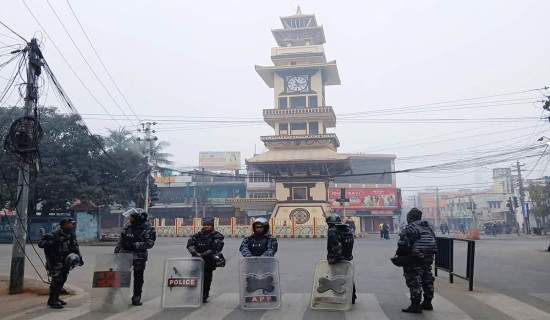- Tuesday, 6 January 2026
Stellar Risk Of Lightning
As Nepal boasts matchless topographical variations, different parts of this nation see totally unlike climatic conditions, depending on changes in elevation. Such altitudinal alterations have an important influence on lighting incidences and subsequent human casualties. Lightning, also a natural disaster, causes thunder, which is a sound from the shock wave. It develops when gases in the nearby area of the discharge witnesses an abrupt rise in pressure. Lightning is an electrostatic release where two electrically charged areas, both in the atmosphere or with one on the ground, briefly deactivate themselves. This triggers an instant discharge of energy. It produces a huge electromagnetic radiation from heat created by the rapid movement of electrons. Lightning happens frequently during thunderstorms and other kinds of energetic weather systems. In Nepal, thunderstorms mostly occur during the period between March and August. With many human and animal casualties, lighting has emerged as the second highest killer following earthquakes. It is also one of the most destructive menaces in the country with a huge quantity of atmospheric water vapour coming from the Indian Ocean.
Lightning strikes are responsible for as many deaths as floods, landslides and storms can cause every year. However, this calamity does not get as much attention as it deserves. Globally, more than 24,000 people lose their lives to this disaster every year. On an average, 103 people have died from lightning annually in Nepal in the past nine years. It has left hundreds of others wounded. This disaster also causes a sense of fear among people. The trepidation caused by lightning is called astraphobia. The country is ahead of many countries around the world in terms of lightning deaths per unit area. Lightning incidences are the least in the mountain region, moderate in the hilly one while they are quite frequent in the southern plains. In terms of population density, the Himalayan region has less lightning than the hilly region while the Terai region has the highest number of occurrences.
It is reported that lightning strikes killed 10 people in various parts of the country within 24 hours on Wednesday alone. According to a news report carried by this daily on Thursday, the casualties were recorded from Kailali, Kanchanpur, Rupandehi, Nawalparasi West, Baglung, Banke, Parsa and Dhading districts. The records maintained by the National Disaster Risk Reduction and Management Authority (NDRRMA) show that the majority of the victims were working in their farms when they were hit by the bolt. It indicates how people working or staying outdoors are vulnerable to this disaster. From April 14 to June 29 this year, more than three dozen individuals died while 58 were wounded in more than 90 lightning incidences nationwide. The age group of the victims range from 13 to 60 years.
Considering the gravity of this hazard, NDRRMA and other agencies associated with disaster management have been calling on people to stay indoors during rains. NDRRMA has also requested parents and seniors to ensure that their children are staying indoors. Experts have also asked people to equip their houses with electric current systems because it allows lightning bolt to discharge safely into the ground. People have been advised not to have any contact with water while staying indoors as lightning can travel along a building’s plumbing. They also must stop using electronic gadgets connected to an electrical outlet during heavy rains coupled with thunderstorms. The relevant authorities need to launch massive public awareness campaigns across the nation to save the lives of people from lightning.













-original-thumb.jpg)



